

© Shipping Wonders of the World 2012-

Coastal Pleasure Steamers
In addition to the well-
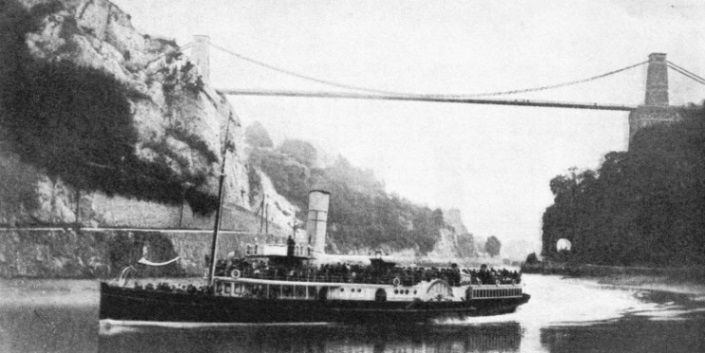
A VETERAN PADDLER, the Lorna Doone, on the River Avon, near the famous Clifton Suspension Bridge. She was built in 1891. In 1898 she was bought by the Southampton, Isle of Wight and South of England Royal Mail Steam Packet Company from a firm which had been running her in the Bristol Channel. She was still in service in 1936 round the Isle of Wight. The Lorna Doone has a gross tonnage of 410 a length of 220 ft. 6 in., a beam of 26 feet and a depth of 9ft. 2 in.
NEARLY every seaside resort on the coast of Great Britain, half a century ago, had at least one pleasure steamer of some sort. Some resorts had harbours in which the steamer could lie comfortably, and some had facilities alongside the promenade piers, but in others it was necessary to run the ship ashore and to rig a light wooden gangway. Many of the services which were maintained at the various resorts have now disappeared. In some the demand has gone altogether; in others the work is done by big companies which cover a number of resorts and maintain regular schedules.
Neither regularity nor good maintenance was a feature of the old days. The steamers were generally owned by a local company composed of tradesmen who would pick up a second-
The Southampton, Isle of Wight and South of England Royal Mail Steam Packet Company (Red Funnel Steamers) was incorporated in 1861. The origin of some of this body’s corporate parts may be traced back to the eighteenth century. In 1774 its predecessors were interested in packets sailing between Southampton and the Isle of Wight with mails and passengers. In 1815 they suggested a service of steamers between Southampton and the Isle of Wight, and within ten years the service was established, the little steamer Prince Coburg maintaining a summer service which covered two round trips daily to the island. In 1833 the Southampton Royal Pier was opened, for the special purpose of catering for the steamboat traffic, and soon several local concerns were taking advantage of it, many of them running trips round the Isle of Wight or along the picturesque Hampshire shore in addition to their regular service.
From time to time the company had to face opposition, either in its own waters or in such resorts as Bournemouth. Sometimes rivals were fought, sometimes they were bought out, but the opposition kept the company keen and efficient, and the public received an excellent service. In 1900 the Balmoral, a 20-
The company not only carried out pleasure trips and maintained services between resorts, but also built up a big fleet of tugs to handle the liners which visited Southampton. The paddlers were used also as tenders for the big ships which, calling at the port on their way to or from New York, preferred to anchor well down Southampton Water, to avoid steaming right up to the docks and paying port dues. Such big ships must not be delayed and the little paddlers had to be sure of keeping absolute time, and had to provide a reasonable measure of comfort for the liner passengers. During the war of 1914-
Oldest British Steamship
Formerly in competition with the Isle of Wight Company, the firm of P. and A. Campbell, started on the Clyde, where Campbell Brothers owned paddle steamers. One of the best known of these, the Waverley, was chartered in 1887 by a syndicate of Bristol business men to run excursions in the Bristol Channel. The possibilities of that area appealed so much to her Scottish owners that some of the partners decided to set up in business there themselves.
They were soon well established and doing remarkably well. An arrangement with the Midland Railway brought thousands of excursionists from the Midlands to the Bristol Channel, and in 1893 the venture which had started in such a small way was registered as a limited liability concern with a capital of £60,000. Later this had to be increased in steps to £250,000. As with the Southampton company, competition from rival concerns had inevitably to be faced. Many of the competing firms, however, after a short fight, were taken over to augment the company’s fleet.
As the company prospered it saw new opportunities and was soon working outside its original area of the Bristol Channel. Where an inefficient local steamboat concern could not keep pace with modern conditions, or where there was room for expansion, there Campbell’s would sooner or later appear.
Gradually they crept round the coast past Southampton to Hastings, Eastbourne and Brighton. Local companies had to be fought, often to be acquired in the end, and sometimes business which Campbell’s enterprise built up attracted rival concerns. The passengers often enjoyed low fares for a time; the tickets for the trip between Brighton and Eastbourne were reduced to sixpence a head while Campbell’s Lorna Doone fought the competition of the Plymouth Belle.
Not only do Campbell steamers still run along the coast, but they also maintain a number of Continental excursions from various points between Worthing and Hastings. When war broke out in 1914 the company had thirteen steamers, of which the biggest was the famous Brighton Queen (553 tons gross), and the latest was the Glen Usk, which had only just been completed. Campbell’s and the rival Southampton company served the Navy valiantly during the war.
At Weymouth, the firm of Cosens and Company perpetuates the enterprise of Captain Joseph Cosens, who, in 1845, began operations with the little paddler Rose running trips from Weymouth to Lyme and Southampton. A clever connexion with the railway, and the pains that he took to keep to regular schedule, brought Captain Cosens considerable business, and he acquired the Highland Maid soon afterwards. Opposition arose, but in the early 1850s the two parties decided that amalgamation was the only sensible course. That is how the famous Premier came into the fleet in 1852. This ship is still capable of doing good work, although she has the distinction of being the oldest steamer on the British register, dating back to 1846-
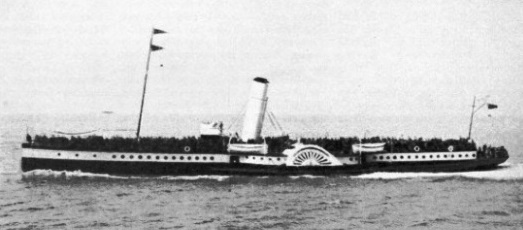
WELL-
The picturesque estuaries and rivers on the Devon coast have in the past been served by a number of pleasure steamers. Some were well worth attention, but most of them were run by single-
The Liverpool and North Wales Steamship Company is an exception, for it has been a flourishing concern for well over a century. The first steamer to connect the Mersey with the North Wales resorts was the little Cambria, built in 1821, and followed immediately by the Albion. In the 1820s the St. George Steam Packet Company, which was normally interested in the Irish Sea mail services, put the Prince Llewellyn on to the North Wales excursion service. In the 1840s that side of the business was taken over by the City of Dublin Steam Packet Company. This service, in its turn, was taken over in 1880 by the Liverpool, Llandudno and Welsh Coast Steamship Company, which ran a number of well-
The Liverpool and North Wales Steamship Company grew out of that concern in 1891, and immediately improved its material with a second St. Tudno and with other ships. Early in 1904 it bought the famous La Marguerite. For many years she was the most popular ship on the run, although the company was building up a large fleet and carried an enormous number of passengers on various services.
Over 2,500 Passengers
As there was good water on the route, the company was able to build economical geared turbine steamers of deep draught. When La Marguerite was finally due for the scrappers the company replaced her by a new St. Tudno, which has a gross tonnage of 2,326, a speed of 19 knots with economical geared turbine engines, and is certificated for over 2,500 passengers. In every way she is a miniature liner, a fine sea-
Blackpool, with its immense number of visitors all intent on enjoying themselves by the sea, has long supported a number of steamers. Before the war of 1914-
More curious was the Queen of the Bay, which was built during the war of 1914-
The Isle of Man Steam Packet Company may in many ways be regarded as operating a packet service, akin to those maintained by the railways, rather than a pleasure service. The enormous number of holiday makers from the north-
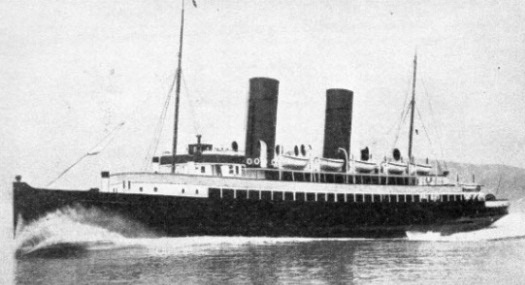
A FAMOUS TURBINE STEAMER, the third Ben-
The regular steam service to the Isle of Man began in 1819 when James Little and Company of Greenock put the Robert Bruce on a triangular service between the Clyde, Douglas and Liverpool. Three years later the St. George Steam Packet Company, which claimed what amounted to a monopoly on the Irish Sea, started a competing service, and in 1826 the steamers Victory and Harriet entered the business. During the 1820s there was a number of steamship companies on the Isle of Man service, but most of them were short-
By 1829 the St. George Company was left with the monopoly and immediately took advantage of it to reduce the standard of its ships, and put its oldest and slowest steamers on to the service in which it had no competition. This annoyed the Manxmen, whose growing trade was largely dependent on a good steamship service to the mainland, and with characteristic enterprise they immediately took steps to form a steamship company of their own. This was originally known as the Mona’s Isle Steam Packet Company, later renamed the Isle of Man United Steam Packet Company, and finally the Isle of Man Steam Packet Company. Its first steamer, a little wooden packet called the Mona’s Isle, was built in 1830.
Finest Ship of Her Type
She averaged eight hours between Liverpool and Douglas and was so well designed that, nearly ten years later, her model was used with little alteration for the pioneer Cunard liners on the transatlantic service. So well did the new concern cover the route that the St. George Company withdrew, but the Mona’s Isle was regarded as being too valuable to risk on the winter service, and the Mona, a much smaller vessel, was built specially to run during the winter months. She must have given her passengers an uncomfortable time.

AT DOUGLAS, ISLE OF MAN. The Mona's Isle is a representative turbine steamer owned by the Isle of Man Steam Packet Company, whose first steamer, built in 1830, had the same name. For many years the company was famous for its big paddlers, but it now owns a number of twin-
Competition has always been the characteristic of the Isle of Man trade, and in 1835 a body of shareholders, dissatisfied with the careful financial policy of the directors, broke away to make a new company, which collapsed after two years. Similar competitors, some from within and some from without, have been appearing ever since, but the company has gone steadily on its way. Its first iron steamer was the Ben-
Round the coast of Scotland conditions are not always suitable for pleasure steamers, although small vessels have to be extensively used for regular transport services. In some parts, however, notably on the Tay and the Forth, there have been some useful pleasure steamers in the past, although few of them remain to-
At the outbreak of war in 1914 nobody in the service took these pleasure steamers seriously, although they were useful as transports between and within the naval ports. They soon proved their value, however, and by the end of the war everybody was willing to admit that the vessels had rendered magnificent service. This service was as varied as it was valuable.
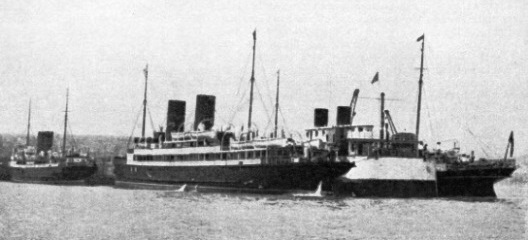
THREE TYPICAL STEAMERS at Douglas, Isle of Man. From left to right they are the Manxman (2,030 tons gross), the Viking (1,957 tons gross) and the Mona’s Isle (1,688 tons gross). All three are triple-
Many of P. and A. Campbell’s crack boats were taken up as paddle minesweepers, their big power and high speed permitting them to sweep important channels with the minimum of delay, and their shallow draught generally enabled them to pass right over the minefields. A few of them, however, were not so fortunate.
Their Barry was renamed H.M.S. Barryfield, and she became a fleet messenger in the Dardanelles campaign, running dispatches between the various points and carrying stores. She distinguished herself in the evacuation, being the last ship to leave Suvla Bay.
The tugs owned by the Southampton, Isle of Wight and South of England Company were taken up, and the company’s paddlers also did extraordinarily useful work. Some of them were mine
sweepers, several going out to the Mediterranean; others acted as patrol vessels in areas where speed and light draught were of special value. Cosens’s paddlers were equally versatile in their naval duties, the Emperor of India, for instance, serving as transport, minesweeper and hospital ship under the name Mahratta. Even the old Premier of 1846 did useful work in carrying naval ratings from point to point.
The bigger steamers of the Liverpool and North Wales Company, including La Marguerite, were used for trooping, and the smaller ones became minesweepers. Several of the Isle of Man Steam Packet Company’s bigger ships were used as armed boarding steamers, maintaining the blockade. The pioneer geared turbine steamer King Orry was used for that purpose, as a trooper and also in connexion with the gunnery practice of the Grand Fleet. The big paddlers Queen Victoria and Prince of Wales were sent out to the Mediterranean as net-
Even to-
A smart little ship, with a gross tonnage of 195, a length of 127 feet between perpendiculars, a beam of 24 ft. 3 in., and a depth of 7 ft. 9 in., she is licensed for nearly 500 passengers, and is capable of a speed of over 10 knots. This is all that is required for ordinary trips to sea, and gives the ship a reasonable chance against the ordinary longshore motor boats.
Further developments have been made with diesel-
The name Ben-
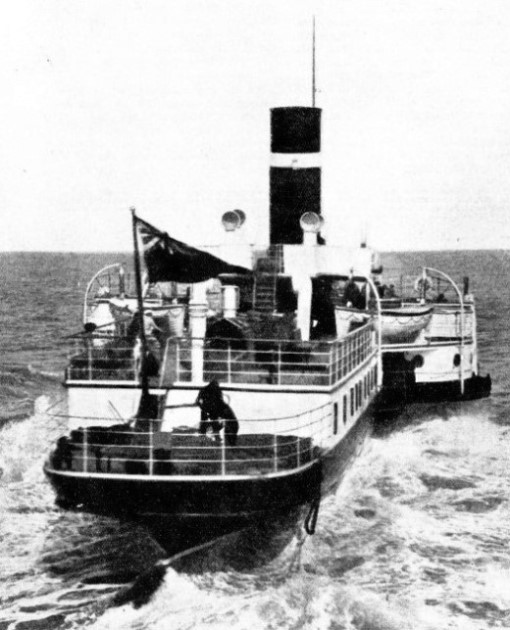
BUILT AT GLASGOW IN 1937, the Barry has a length of 225 ft. 6 in., a beam of 26 ft. 7 in. and a depth of 8 ft. 8 in. During the war of 1914-
You can read more on “Romantic Sailing Coasters”, “The Talisman” and
“Thames Butterfly Boats” on this website.